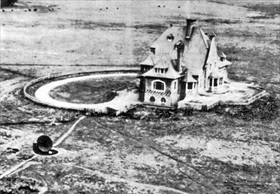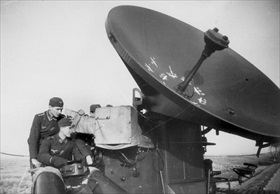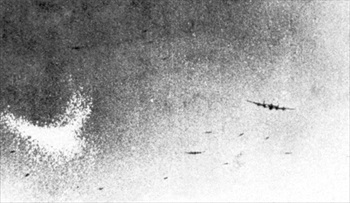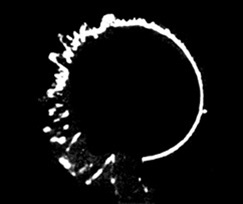REWARDS LIKELY FROM RADAR STATION RAID
London, England · February 27, 1942
Under the cover of darkness on this date in 1942, over 100 British paratroopers kicked off Operation Biting when they parachuted into Nazi-occupied Normandy close to a German radar station in the tiny village of La Poterie-Cap-d’Antifer, 12 miles north of the large French harbor of Le Havre. A number of what were inferred to be ground radar installations had been identified by the Royal Air Force during aerial reconnaissance in 1941, but their exact purpose and, of course, the nature of the equipment housed inside were yet unknown. On landing, the paratroopers quickly overcame the lone sentry guarding the Wuerzburg radar array, disassembled the dish antenna as a nearby enemy pillbox fired on them, removed and packed important components, and left for the nearby beach at Bruneval. (The commando-type raid is sometimes known as Operation Bruneval.) From the beach six Royal Navy landing craft took the raiders and their booty, including one German radar technician, back to England where the technology could be studied and countermeasures designed and implemented to neutralize its effectiveness. That was when British scientists discovered that all German ground-based radar stations operated on a small number of frequencies, and that the radar stations could be easily jammed by air-dropping aluminum strips (variously called “window” or “snowflake”), thereby swamping an operator’s radar screen with multiple returns. Operation Gomorrah, the huge and devastating Allied bombing raids on the north German port of Hamburg in late July/early August 1943 succeeded in part by using this reflecting chaff. Even though Germans had pioneered its use—chaff was known as “Dueppel” in German—they did nothing to prepare themselves for its use by the enemy. The month before Gomorrah, after a British photo interpreter had identified a stack of Wuerzburg dish antennas in a manufacturing yard in Friedrichshafen on Lake Constance (southern Germany), Prime Minister Winston Churchill ordered the RAF to bomb the site. Notwithstanding successful Allied countermeasures and the 1943 aerial assault on the suspected production facility, some 4,000 Wuerzburg stations found their way into Wehrmacht service starting in 1941.
[amazon_carousel widget_type=”ASINList” width=”600″ height=”200″ title=”Recommended Reading” market_place=”US” shuffle_products=”False” show_border=”False” asin=”1846038499,0142004804,1849083908,184176986X,0141042826,0750306599,1426921101,0684835290,1400067618,0764305670″ /]
German Ground-Based Wuerzburg Radar Equipment
 |  |
Left: RAF photo-reconnaissance picture of the Wuerzburg radar array (dark round object left in photo) adjacent to the Bruneval villa, Normandy coast, December 1941.
![]()
Right: Wuerzburg radar apparatus installed near the English Channel, France, 1943. The February 1942 Bruneval raid provided British intelligence with a close-up view of the new German air defense radars: their vital components, how the radar equipment was used, and on what frequencies the radar operated, all of which were crucial if Allied long-range bombers and fighter aircraft were to operate effectively over Nazi-occupied Europe.
 |  |
Left: An RAF Avro Lancaster dropping metallic chaff (the crescent-shaped white cloud in the left of the picture) to interfere with anti-aircraft batteries during a thousand-bomber stream over Essen, Germany. No date.
![]()
Right: The effect of chaff on the display of a Giant Wuerzburg radar scope. The effect of jamming appears in the left “jagged” half of the circular ring, contrasting with the normal “smooth” (unjammed) display on the right half of the circle, with a real target at the 3 o’clock position. On the jammed left side, the real target “blip” would have been indistinguishable from the chaff.
Brief History of Radar’s Influence on War in European and Pacific Theaters
![]()

 History buffs, there is good news! The Daily Chronicles of World War II is now available as an ebook for $4.99 on Amazon.com. Containing a year’s worth of dated entries from this website, the ebook brings the story of this tumultuous era to life in a compelling, authoritative, and succinct manner. Featuring inventive navigation aids, the ebook enables readers to instantly move forward or backward by month and date to different dated entries. Simple and elegant! Click
History buffs, there is good news! The Daily Chronicles of World War II is now available as an ebook for $4.99 on Amazon.com. Containing a year’s worth of dated entries from this website, the ebook brings the story of this tumultuous era to life in a compelling, authoritative, and succinct manner. Featuring inventive navigation aids, the ebook enables readers to instantly move forward or backward by month and date to different dated entries. Simple and elegant! Click 











